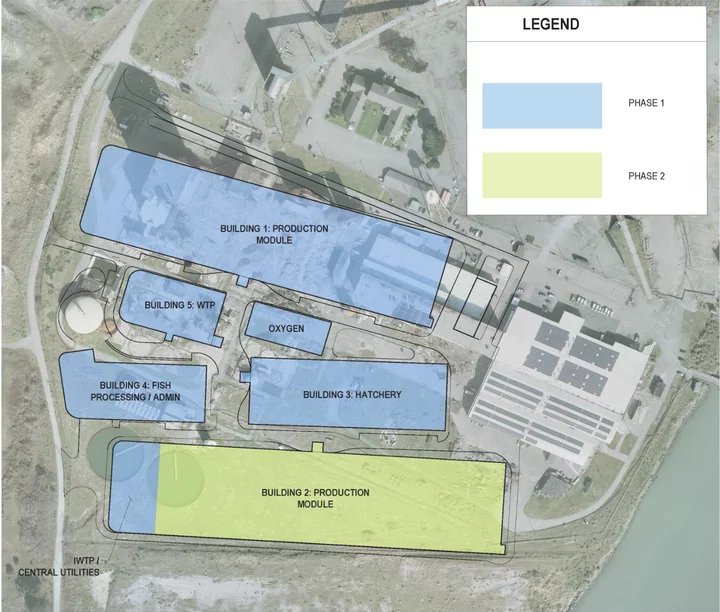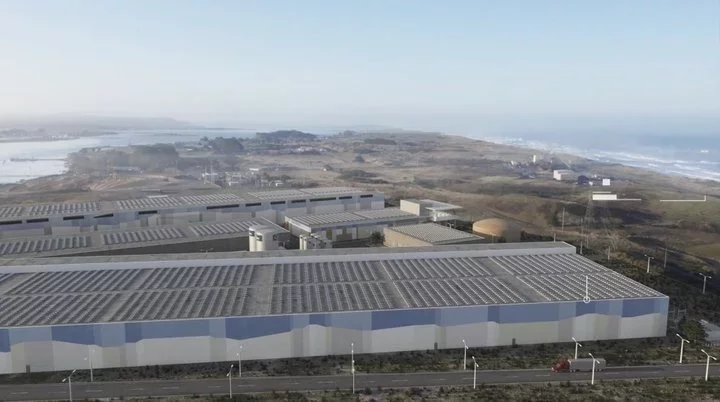Diagram of the planned recirculating aquaculture system facility proposed for construction at a former pulp mill property on the Samoa Peninsula. | Image via County of Humboldt.
###
PREVIOUSLY:
- Nordic Aquafarms Lays out Next Steps After Planning Commission Gives the Thumbs-Up to Their Samoa Fish Farm Plans
- Fishermen and Conservation Groups Appeal Nordic Aquafarms’ Environmental Report Certification to Humboldt County Supervisors
###
The Humboldt County Board of Supervisors will hold a special public hearing on Wednesday to consider an appeal concerning Nordic Aquafarms’ big land-based fish farm project.
The Norway-based company plans to demolish a dilapidated pulp mill site on the Samoa Peninsula and in its place build a 766,530-square-foot, land-based recirculating aquaculture facility. The latest estimates put the project’s total cost around $650 million, with a stated end goal of producing 25,000 metric tons of Atlantic salmon per year for distribution up and down the West Coast.
The appeal was filed by three groups: the Redwood Region chapter of the Audubon Society, the climate action nonprofit 350 Humboldt and the Humboldt Fisherman’s Marketing Association, Inc. Their appeal argues that the Humboldt County Planning Commission erred on August 4 when it voted unanimously to approve a Coastal Development Permit and Special Permit and to certify the project’s Environmental Impact Report (EIR).
The appeal argues more specifically that the project’s EIR — prepared by engineering firm GHD on behalf of the county — does not accurately evaluate a range of project impacts, including its energy use, the greenhouse gas emissions associated with fish feed production and truck traffic, and the biological impacts of the project’s saltwater intake and effluent outfall systems, among other matters.
The appellants also say the county should have given more consideration to project alternatives — either a smaller project or no project at all — and that the county didn’t properly follow the California Environmental Quality Act (CEQA) process because the project’s various elements were considered in a “piecemeal” fashion, rather than cumulatively.
In a report prepared for Wednesday’s meeting, county staff pushes back against those arguments, saying the project’s EIR does, in fact, evaluate and assess all components of the project, with “numerous technical reports executed by subject matter experts within their respective fields, consistent with CEQA Guidelines.”
Project plans call for the use of about 2.5 million gallons of domestic and industrial freshwater per day provided by the Humboldt Bay Municipal Water District. That may sound like a lot, but as HBMWD General Manager John Friedenbach has pointed out, the district used to provide more than 25 times that much (65 million gallons per day) of untreated water from the Mad River to the two pulp mills that used to operate on the peninsula.
The project would also require approximately 10 million daily gallons of saltwater, provided via a modernized seawater intake system known as a “sea chest,” operated by the Humboldt Bay Harbor, Recreation, and Conservation District. About 12.5 million gallons of treated wastewater would be discharged daily via an existing ocean outfall pipe that extends a mile and a half offshore.
The project’s estimated daily electricity usage would be 21.4 megawatts, with an annual usage at full build-out of 195 gigawatt hours (GWh). That’s roughly equivalent to the energy use of the cities of Eureka and Fortuna combined, though a portion would be offset by a 3-5 megawatt solar installation covering roughly 657,000 square feet of the facility’s rooftops.
Nordic has committed to purchasing 100 percent non-carbon, renewable energy, per the goals of the Redwood Coast Energy Authority, though it’s not yet clear how the project’s massive energy needs will impact the county’s electrical grid, large portions of which are now operating at the outer limits of current transmission capacity, according to PG&E.
Proponents of the project have noted that Nordic Aquafarms plans to spend $10 million on environmental mitigation, continuing cleanup of the heavily polluted old pulp mill site. The company also expects to create several hundred jobs in the building trades during its two-phase, multi-year construction and about 150 permanent, full-time positions once the facility is fully built out.
Critics, meanwhile, have raised concerns over the project’s energy use, the impacts of its intake and discharge facilities and the relatively untested technology at this scale.
At the Planning Commission’s August 4 hearing, under pressure from local environmental groups, the applicant agreed to begin monitoring discharge from the outfall line as soon as the project becomes operational.
The appellants filed their appeal on August 18. Wednesday’s hearing, which will be held in board chambers and streamed online via Zoom, is scheduled to begin at 9 a.m.
Computer-generated mock-up of the land-based fish farm Nordic Aquafarms plans for the Samoa Peninsula.



CLICK TO MANAGE